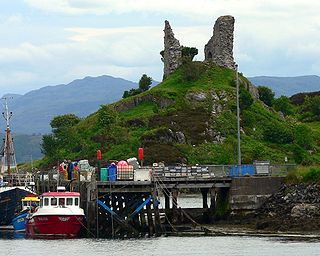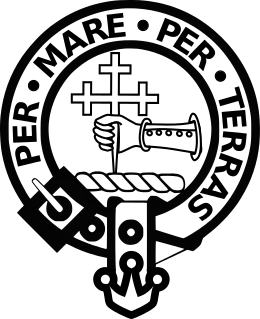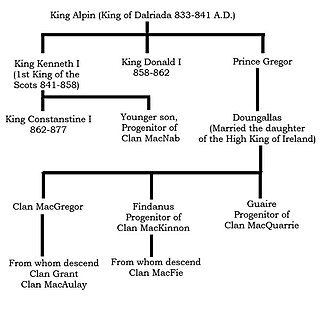Related Research Articles

Clan Ross is a Highland Scottish clan. The original chiefs of the clan were the original Earls of Ross.

Clan MacLeod is a Highland Scottish clan associated with the Isle of Skye. There are two main branches of the clan: the MacLeods of Harris and Dunvegan, whose chief is MacLeod of MacLeod, are known in Gaelic as Sìol Tormoid ; the Clan MacLeod of Lewis and Raasay, whose chief is MacLeod of The Lewes, are known in Gaelic as Sìol Torcaill. Both branches claim descent from Leòd, who lived in the 13th century.

Dunvegan Castle is located 1 mile (1.6 km) to the north of Dunvegan on the Isle of Skye, off the west coast of Scotland. It is the seat of the MacLeod of MacLeod, chief of the Clan MacLeod. Probably a fortified site from the earliest times, the castle was first built in the 13th century and developed piecemeal over the centuries. In the 19th century the whole castle was remodelled in a mock-medieval style. The castle is built on an elevated rock overlooking an inlet on the eastern shore of Loch Dunvegan, a sea loch.
Leod is considered the eponymous ancestor and founder of Clan MacLeod and Clan MacLeod of Lewis. Almost nothing is known about him and he does not appear in any contemporary records. Tradition dating to the late 18th century made him a son of Olaf the Black who was King of Man. Heraldic evidence, dating to the late 17th century, is considered to be the earliest evidence of descent from Olaf the Black. However, in recent years, this traditional lineage has been challenged and is no longer considered fact by one historian.

Clan Donald, also known as Clan MacDonald, is a Highland Scottish clan and one of the largest Scottish clans. The Lord Lyon King of Arms, who is the Scottish official with responsibility for regulating heraldry in that country, issuing new grants of coats of arms, and serving as the judge of the Court of the Lord Lyon, recognizes under Scottish law the High Chief of Clan Donald. Historically the chiefs of the Clan Donald held the title of Lord of the Isles until 1493 and two of those chiefs also held the title of Earl of Ross until 1476.

Clan Nicolson is a Lowland Scottish clan. The clan claims descent from an Edinburgh lawyer who lived in the 16th century and from a distinguished line of Aberdeen merchants who preceded him. During the mid-1980s David Nicolson, 4th Baron Carnock was recognised by the Lord Lyon King of Arms as the chief of Clan Nicolson. Around the same time, a Nicolson who claimed descent from the Highland clan of "Nicolsons" historically centred on Skye, petitioned the Lord Lyon King of Arms to be recognised as chief of his own clan. The Lord Lyon King of Arms accepted this man's petition on the condition he took the surname MacNeacail. In consequence there are two Scottish clans with similar names—the lowland Clan Nicolson and the highland Clan MacNeacail.

Clan MacNeacail, sometimes known as Clan MacNicol, is a Scottish clan long associated with the Isle of Skye. Tradition states that, early in its history, the clan held the Isle of Lewis, as well as extensive territory on the north-western mainland. The earliest member of the clan on record is one 14th century John "mak Nakyl", who is recorded amongst Edward I of England's powerful West Highland supporters during the Wars of Scottish Independence. John Barbour's 1375 epic, The Brus, suggests that by 1316, the clan had switched allegiance to Robert I, and made a decisive intervention in the new theatre of Anglo-Scottish conflict in Ireland. The marriage of an heiress to the MacLeods of Lewis brought a severe loss of lands and power in the following generation, forcing the clan chiefs to relocate to the surviving estates on Skye. However, the MacNeacails retained local significant influence: serving, according to tradition, as members of the Council of the Lords of the Isles and as custodians of the cathedral church of the Western Isles at Snizort. In the 17th century, members of the clan began to Anglicise their surname from the Scottish Gaelic MacNeacail to various forms, such as Nicolson. Today the English variants of the Gaelic surname are borne by members of the clan as well as members of unrelated Scottish families, including the Lowland Clan Nicolson.

Clan MacInnes is a Scottish clan originally from the western highlands of Scotland. The origin of clan is Morvern and Ardgour, Argylshire, with its clan name coming into existence in the 13th century. The clan's chief and his heirs were assassinated in the 14th century meaning that the clan no longer has a clan chief. Clan MacInnes is not associated - in any way - with the Clan Innes which hails from Moray.

Clan MacKinnon or Clan Fingon is a Highland Scottish clan associated with the islands of Mull and Skye, in the Inner Hebrides.

Caisteal Maol is a ruined castle located near the harbour of the village of Kyleakin, Isle of Skye, Scotland. It is also known as Castle Moil, Castle Maol, Dun Akyn, Dunakin CastleDun Haakon and Castle Dunakin.

Clan Macdonald of Sleat, sometimes known as Clan Donald North and in Gaelic Clann Ùisdein[kʰl̪ˠan̪ˠ ˈuːʃtʲɛɲ], is a Scottish clan and a branch of Clan Donald — one of the largest Scottish clans. The founder of the Macdonalds of Sleat was Ùisdean, or Hugh, a 6th great-grandson of Somerled, a 12th-century Lord of the Isles. The clan is known in Gaelic as Clann Ùisdein, and its chief's Gaelic designation is Mac Ùisdein, in reference to the clan's founder. Both the clan and its clan chief are recognised by the Lord Lyon King of Arms, who is the heraldic authority in Scotland.

Clan MacLeod of The Lewes, commonly known as Clan MacLeod of Lewis, is a Highland Scottish clan, which at its height held extensive lands in the Western Isles and west coast of Scotland. From the 14th century up until the beginning of the 17th century there were two branches of Macleods: the MacLeods of Dunvegan and Harris ; and the Macleods of the Isle of Lewis. In Gaelic the Macleods of Lewis were known as Sìol Thorcaill, and the MacLeods of Dunvegan and Harris were known as Sìol Thormoid.

Clan Matheson is a Highland Scottish clan.

Siol Alpin is a family of seven Scottish clans traditionally claiming descent from Alpin, father of Cináed mac Ailpín, King of the Picts, of whom the Scots tradition considered the first King of Scots. The seven clans that make up Siol Alpin are: Clan Grant, Clan Gregor, Clan MacAulay, Clan Macfie, Clan Mackinnon, Clan Macnab, and Clan MacQuarrie.

Dun Ringill is an Iron Age hill fort on the Strathaird peninsula on the island of Skye, Scotland. Further fortified in the Middle Ages, tradition holds that it was for several centuries the seat of Clan MacKinnon. It is located east of Kirkibost on the west shore of Loch Slapin.

The Isle of Skye, or simply Skye, is the largest and northernmost of the major islands in the Inner Hebrides of Scotland. The island's peninsulas radiate from a mountainous hub dominated by the Cuillin, the rocky slopes of which provide some of the most dramatic mountain scenery in the country. Although Sgitheanach has been suggested to describe a winged shape, no definitive agreement exists as to the name's origins.
Sir Roderick Macleod of Macleod (1573–1626), also known as Rory Mor, was the 15th Chief of Clan MacLeod.

Iain Borb MacLeod (1392–1442) is considered to be the sixth chief of Clan MacLeod. He is the first MacLeod chief to which heraldry can be assigned. Clan tradition states that he was a minor at the time of his father's death and for six years an incompetent guardian led the clan to its lowest point in clan history. After reaching the age of maturity, Iain Borb managed to acquire some of the clan's lost lands and led his clan and his kinsmen in the Battle of Harlaw, in 1411. Iain Borb was wounded in the head during the conflict; the wound never completely healed and confined him to his home on Pabbay for much of his life. Tradition states that he died when this wound re-opened during a fencing/wrestling match. There is some disagreement as to which of his sons was the eldest; however, his son William Dubh was the one who finally succeeded to the chiefship, following his death in 1442.

Lochalsh is a district of mainland Scotland that is currently part of the Highland council area. It is a hilly peninsula that lies between Loch Carron and Loch Alsh. The main settlement is Kyle of Lochalsh, located at the entrance to Loch Alsh, opposite the village of Kyleakin on the adjacent island of Skye. A ferry used to connect the two settlements but was replaced by the Skye Bridge in 1995.
Charles Roy Stuart-Vernon, Laird MacKinnon of Dunakin, was a prolific British writer. He wrote historical books and novels of diverse genres under various pseudonyms: Charles Stuart, Charles MacKinnon, Charles MacKinnon of Dunakin, C. R. MacKinnon of Dunakin, C. R. MacKinnon, Graham Montrose, Iain Torr, I. Torr, Vivian Stuart, Vivian Donald and Barbara Lynn.
References
- ↑ MacKinnon, C., Scottish Highlanders, 1992, Barnes and Noble Books, ISBN 0-88029-950-9
- ↑ The Genealogy of the Clan MacKinnon from Clan documents